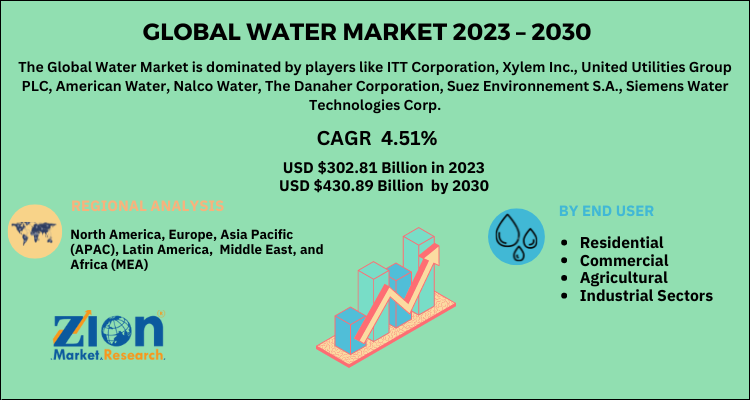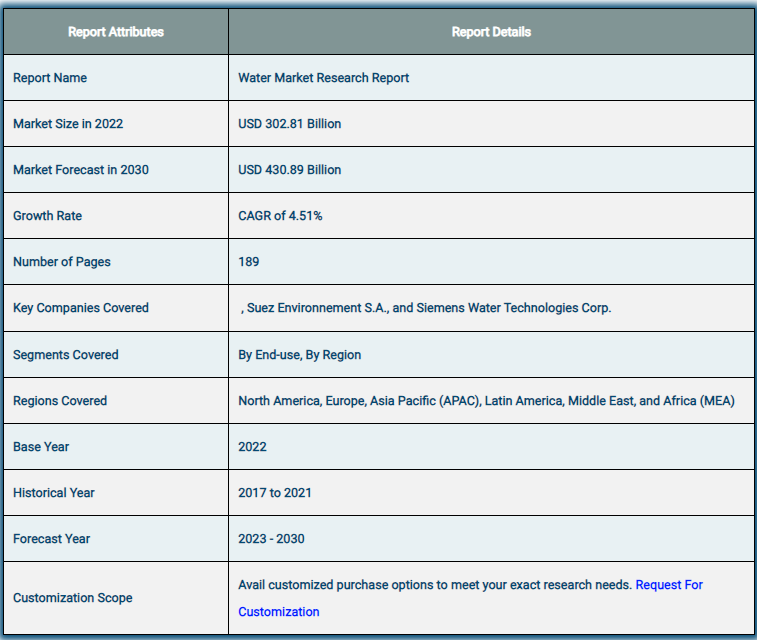🌊Water Market Size, Share, Growth Report(2024–2032)

The worldwide water market was estimated to be worth USD 302.81 billion in 2024 and is expected to grow to USD 430.89 billion by the end of 2032, according to a report released by Zion Market Research. Over the course of the projection period, the market is anticipated to rise at a CAGR of 4.51%. The growth factors, barriers, and effects on demand of the worldwide water market are examined in this study for the period of forecasting. Additionally, it will support exploration and navigation of the emerging opportunities in the Water Market sector.
✈👉Get a Free Sample: 🚀https://www.zionmarketresearch.com/sample/water-market
Introduction
The global water market is a critical sector that encompasses the supply, distribution, and management of water resources. As one of the most vital commodities for human survival, the water market faces significant challenges and opportunities driven by population growth, climate change, and technological advancements. This article explores the current state of the water market, emerging trends, key drivers, and future prospects.

The Market for Water: An Overview
Water is a basic resource that is used in every industry. Water is supplied by the global water market for a variety of uses, including commercial, industrial, and domestic. Numerous industries, including electricity generation, pulp and paper, petrochemicals and refining, food and beverage, microelectronics, oil and gas, mining, and pharmaceuticals, are included in the industrial sector itself. Fresh water is necessary for every industry, but the need goes beyond supply.Two million tonnes of human waste are disposed of in water courses every day in underdeveloped countries, where 70 percent of industrial waste is dumped untreated into rivers and contaminates the supply of potable water.
Wastewater recycling therefore becomes crucial. The municipal and industrial sectors are being forced to invest in wastewater reusability due to the paucity of freshwater. The most widely used techniques for treating wastewater are biological treatment, oxidation and disinfection, removal of suspended and dissolved solids, and separation of oil and water. Growing expenditures on these approaches have had a favourable and significant influence on market expansion.

Market Segmentation for Water
Based on regions and end-use, the global water market can be divided into segments. The global market is divided into four sectors based on the end-user: residential, commercial, agricultural, and industrial. The residential market is further divided into segments for indoor and outdoor use. The Asia Pacific, Europe, North America, Latin America, Middle East, and Africa areas comprise the worldwide water market.
Market Growth Factors for Water
The primary drivers of the global water market’s growth are industrialisation and urbanisation. Due to the aforementioned factors, developing nations are the primary areas where the market is expanding. The economy and people are growing quickly, which is contributing to the expansion of the water market. The need to use the limited water carefully has increased due to the need for fresh water. Developed nations have also added their share to the market expansion, in addition to developing ones. The importance of smart water solutions has increased recently due to network efficiency, leak detection, and water scarcity. The need for the water market is great in the nations where agriculture is still the primary industry. The end users propelling the expansion of the global water market are the commercial sectors, which include hotels, hospitals, and others.
✈👉Directly Purchase a copy of the report with TOC: 🚀https://www.zionmarketresearch.com/toc/water-market
Water Market: Report Purpose

Regional Analysis of the Water Market
Due in large part to the expansion of the building and manufacturing sectors, which has raised demand for water, Asia Pacific now leads the world market for water. An important factor in the expansion of the water market in this area is the growing population. Furthermore, as a result of significant government investments in waste water treatment facilities to promote urbanisation, nations like China, Japan, and India are bolstering the expansion of the water industry. Other factors propelling the expansion of the European water market are bottled water and the growing use of water in many sectors. There is potential for the water market to grow in areas like the Middle East and North Africa because of the poor quality of the water in these areas.
Key Market Trends
- Technological Advancements Innovations in water technology are transforming the market. Smart water management systems, advanced filtration technologies, and desalination processes are improving efficiency and sustainability. The integration of IoT (Internet of Things) and AI (Artificial Intelligence) is enhancing water monitoring, leak detection, and resource management.
- Sustainability and Conservation There is a growing emphasis on sustainability and conservation in the water sector. Companies and governments are focusing on reducing water waste, improving water use efficiency, and promoting the reuse and recycling of water. Sustainable practices are becoming integral to water management strategies, driven by both regulatory pressures and consumer demand.
- Climate Change Impact Climate change is impacting water availability and quality, leading to increased frequency of droughts, floods, and extreme weather events. These changes are driving investments in climate-resilient infrastructure and water management practices to mitigate the effects of climate variability.
- Urbanization and Population Growth Rapid urbanization and population growth are putting pressure on existing water resources and infrastructure. Expanding cities and increasing industrial activities require significant investment in water supply and treatment infrastructure to meet the rising demand for clean water.
- Regulatory and Policy Changes Governments and regulatory bodies are implementing stricter regulations and policies to ensure water quality, protect resources, and promote sustainability. Compliance with these regulations is essential for water utilities and companies operating in the sector.
Competitive Landscape
- Key Players and Market Dynamics The water market features a mix of large multinational corporations and specialized technology providers. Major players include companies such as Veolia, SUEZ, and Danaher, which offer a range of water-related products and services. The competitive landscape is characterized by ongoing innovation, mergers and acquisitions, and strategic partnerships.
- Emerging Companies and Innovations Startups and emerging companies are introducing innovative solutions in areas such as water treatment, smart water technology, and resource management. These companies are driving disruption and competition in the market with novel technologies and approaches.
- Investment and Funding Investment in water infrastructure and technology is increasing, driven by both public and private sector funding. Governments, international organizations, and venture capitalists are supporting projects that aim to enhance water access, improve efficiency, and address global water challenges.
Consumer Behavior
- Increased Awareness and Demand for Clean Water Consumers are becoming more aware of water quality issues and are demanding cleaner and safer water. This awareness is driving demand for advanced water filtration systems, bottled water, and products that ensure water safety.
- Preference for Sustainable Solutions There is a growing preference for sustainable and eco-friendly water solutions. Consumers are seeking products and services that align with environmental and conservation goals, such as water-saving technologies and recyclable packaging.
- Urban vs. Rural Water Access Disparities in water access between urban and rural areas are a key concern. Urban areas often have better access to clean water and infrastructure, while rural areas may face challenges such as inadequate infrastructure and limited resources.
Challenges and Opportunities
- Infrastructure Aging and Investment Needs Many water infrastructure systems are aging and require significant investment for upgrades and maintenance. Addressing these needs presents both challenges and opportunities for companies involved in infrastructure development and repair.
- Water Scarcity and Management Water scarcity is a growing concern, particularly in arid regions and developing countries. Effective water management and conservation strategies are crucial for addressing scarcity and ensuring sustainable water availability.
- Regulatory Compliance Navigating complex regulatory requirements and ensuring compliance can be challenging for water companies. Staying updated with regulations and implementing best practices is essential for avoiding penalties and maintaining operational efficiency.
Future Outlook
The future of the water market is characterized by continued growth and transformation. Technological advancements, sustainability efforts, and regulatory developments will shape the market’s trajectory. Companies that can innovate, adapt to changing conditions, and address emerging challenges will be well-positioned to succeed in the evolving water sector.
Conclusion
The water market is a dynamic and essential sector with significant opportunities for growth and development. As the global population continues to grow and climate change impacts water resources, there will be an increasing need for advanced technologies, sustainable practices, and effective water management strategies. By addressing current challenges and leveraging emerging trends, stakeholders in the water market can contribute to a more resilient and sustainable future.
✈👉Enquiry for buying: 🚀https://www.zionmarketresearch.com/inquiry/water-market
📞Contact Us:
Zion Market Research212
USA/Canada Toll Free: 1 (855) 465–4651
Newark: 1 (302) 444–016611\
📲Web: https://www.zionmarketresearch.com/
👉Blog: https://zmrblog.com/
Browse other trend reports:
https://medium.com/@sachinkumbharnagaj/water-market-size-share-growth-report-2024-2032-5d5552e02574
https://medium.com/@gk4040408/water-market-size-share-growth-report-2024-2032-8579417704ee
https://medium.com/@smrfrenchmarket/water-market-size-share-growth-report-2024-2032-c3ca8189d373
https://willietorres6004.medium.com/water-market-size-share-growth-report-2024-2032-a9ed4a45f8b9
https://www.linkedin.com/pulse/vietnam-skin-care-products-market-size-share-report-5uxof
https://www.linkedin.com/pulse/content-reduction-ingredients-market-size-share-cq2ef
https://www.linkedin.com/pulse/water-market-size-share-growth-report2024-2032-w00wf
https://www.linkedin.com/pulse/synthetic-bio-based-coatings-automotives-market-urugf
https://www.linkedin.com/pulse/variable-data-printing-market-size-share-growth-b8sje
https://www.linkedin.com/pulse/service-delivery-automation-market-trend-share-growth-size-bv0he
https://www.linkedin.com/pulse/biocides-market-growth-size-share-trends-forecast-2024-2032-xlvge
https://teamcnut.com/biosurgery-market-size-share-trends-opportunities-growth-analysis-to-2032/
%20Market%20main%20jpg.png)
Comments
Post a Comment